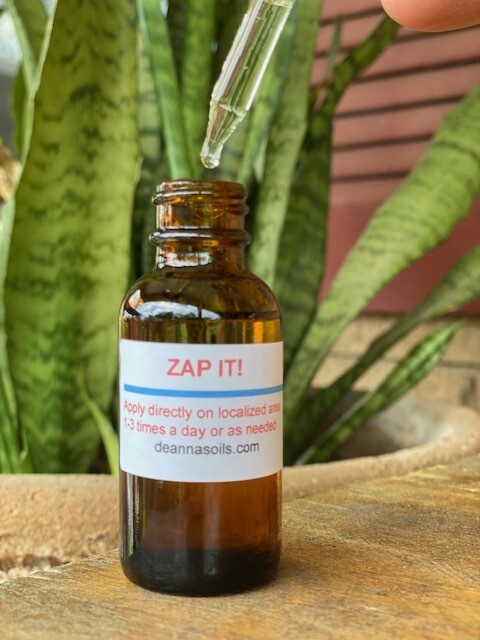ZAP IT!
Zap It! is a blend of organic, therapeutic essential oils. This blend is for severe skin disorders and might help acute or malignant issues. You can apply it topically 2-3 times a day or as needed. In this blend:
Roman Chamomile (Chamaemelum nobile).
Therapeutic Properties
Analgesic: Roman chamomile was traditionally used to relieve pain (Gordon 1980, Grieve 1992).
Anti-inflammatory: Price and Price (2007) suggest that Roman chamomile has anti-inflammatory action.
Antispasmodic: Pénoël and Franchomme (1990) state that the esters in Roman chamomile have antispasmodic activity.
CNS sedative: The scent of Roman chamomile has a calming, sedating effect (Moss et al. 2006).
Skin healing: Roman chamomile may help counteract inflammation and support the healing process.
Tonic: Traditionally used as a tonic to strengthen and restore vitality.
Frankincense (Boswellia carterii)
Therapeutic Properties
Analgesic: The presence of components such as α- and β-pinene, d-limonene, β-myrcene, and para-cymene (among others) suggests that the oil has excellent pain relieving properties.
Anti-inflammatory: Hirota et al. (2010) noted that d-limonene, a component in some frankincense essential oils, has considerable anti-inflammatory activity—it decreases cell migration and cytokine release and shows excellent antioxidant activity.
Antioxidant: Yang et al. (2010) reported that Frankincense oil has considerable free radical scavenging action. See also anti-inflammatory.
Cicatrisant: The essential oil contains several components that demonstrate actions important to the skin’s healing process. Many are antioxidant, anti-inflammatory, and antibacterial. Anecdotal evidence certainly suggests that Frankincense plays a role in skin care.
Immunostimulant: Oils such as frankincense that have anti-inflammatory, antioxidant, and antimicrobial properties may offer strong immune support.
Helichrysum (Helichrysum italicum).
Therapeutic Properties
Analgesic: The essential oil has pain-relieving actions. Voinchet and Giraud-Robert (2007) suggested that neryl acetate, a principal constituent, contributed to this effect. See wound healing.
Anti-allergenic: By reducing inflammation, pain, and swelling, Helichrysum can be used to relieve allergies that manifest in the skin.
Anti-inflammatory: The anti-inflammatory effect is thought to be due, in part, to neryl acetate (Voinchet and Giraud-Robert 2007).
Antibacterial: The essential oil significantly reduced the multidrug resistance of the Gram-negative Enterobacter aerogenes, E.coli, Pseudomonas aeruginosa, and Acetobacter baumanni (Lorenzi et al. 2009). Helichrysum was also included in a study investigating the antimicrobial activities of essential oils whose principal constituents have floral-rosy aromas (Jirovetz et al. 2006). All of the oils and most of the principal aroma compounds showed medium-to-high antimicrobial activities against both Gram-positive and Gram-negative bacteria.
Antidepressant: Many people report that the scent of Helichrysum is uplifting.
Antihaematomal: Antihaematomal action is the ability to prevent and alleviate bruising after soft tissue trauma. Helichrysum is notable in this respect. Bowles (2003) suggests that this could be due to the presence of italidiones (diketones). The antihaematomal effect might be due to a combination of anti-inflammatory action, vasodilatory effects, and prevention of edema.
Antispasmodic: The high ester content (neryl acetate) of the essential oil suggests that it might have antispasmodic action.
Cicatrisant: See wound healing.
Skin healing: See wound healing.
Tonic: The antidepressant and uplifting effects of the essential oil enhance vitality and well-being.
Wound healing: Voinchet and Giraud-Robert (2007) investigated the therapeutic effects and potential clinical applications of Helichrysum italicum var. serotinum diluted in a macerated oil of musk rose (Rosa rubiginosa) after cosmetic and reconstructive surgery. This combination reduced inflammation, edema, and bruising. They attributed these effects to italidiones.
Myrrh (Commiphora myrrha).
Therapeutic Properties
Analgesic: Myrrh has analgesic and anti-inflammatory activity (Su et al. 2011).
Antifungal: from experience, we have seen that it can support the healing of slow healing fungus.
Anti-inflammatory: Myrrh has good anti-inflammatory action (Su et al. 2011). It is used in Chinese medicine for arthritis, and in Ayurveda for inflammatory diseases (Shen et al. 2012).
Antioxidant: Myrrh essential oil is a singlet oxygen quencher (Tonkal and Morsy 2008).
Astringent: Resin oils were used as astringents in traditional medicine, and their essential oils are often used in the same way.
Calming: Resins were used for calming and meditation and their essential oils are often used in the same way.
Cicatrisant: See skin healing.
Skin healing: The oil is anti-inflammatory and has good skin protection and regenerating potential (Baylac and Racine 2004).
Warming: Myrrh is regarded as a warming remedy in traditional medicines, used to alleviate conditions associated with cold and damp, such as arthritis.
Aroma
Myrrh essential oil is spicy, somewhat balsamic, and sharp with a medicinal note. It becomes sticky and resin-like upon exposure to air, and as it ages the oil becomes softer and mellower, losing the sharp medicinal element. It blends very well with other resins such as frankincense and opopanax, the ‘Myrrh of antiquity.’
There are a total of 10 Organic Essential Oils in this blend. All are known for their healing abilities for skin.

